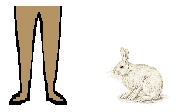Snowshoe Rabbit

| Class: Mammalia:
Mammals |
Diet: Plants |
| Order:
Lagomorpha: Lagomorphs |
| Size: body:
36 - 52 cm (14 1/4 - 20 1/2 in), tail: 2.5 - 5.5 cm (1 - 2 1.4 in) |
| Family: Leporidae:
Rabbits and Hares |
Conservation Status:
Non-threatened |
| Scientific Name:
Lepus americanus |
Habitat: forest,
swamps, thickets |
| Range:
Alaska, Canada, Northern U.S.A. |
 Also
known as the varying hare, this animal has a dark-brown coat in summer
that turns white in winter, except for a black edging on the ear tips.
This coat is of undoubted camouflage value, although in fact only the visible
tips of the hairs are pure white. Usually active at night and in the early
morning, the snowshoe rabbit feeds on juicy green plants and grass in summer
and twigs, shoots and buds in winter. Also
known as the varying hare, this animal has a dark-brown coat in summer
that turns white in winter, except for a black edging on the ear tips.
This coat is of undoubted camouflage value, although in fact only the visible
tips of the hairs are pure white. Usually active at night and in the early
morning, the snowshoe rabbit feeds on juicy green plants and grass in summer
and twigs, shoots and buds in winter.
The population of these animals fluctuates tremendously
on a roughly 10-year cycle, due to the availability of food and predator
interactions. Breeding begins in March, and there may be two or three litters,
each of 1 to 7, usually 4, young, which are born well furred, with their
eyes open.

  
|
